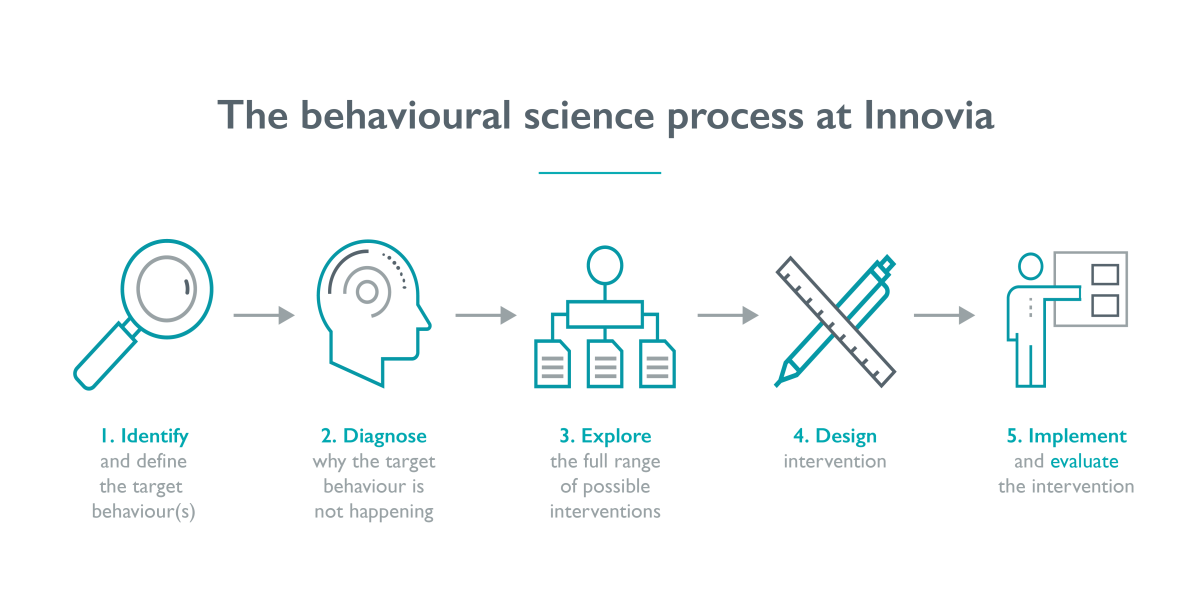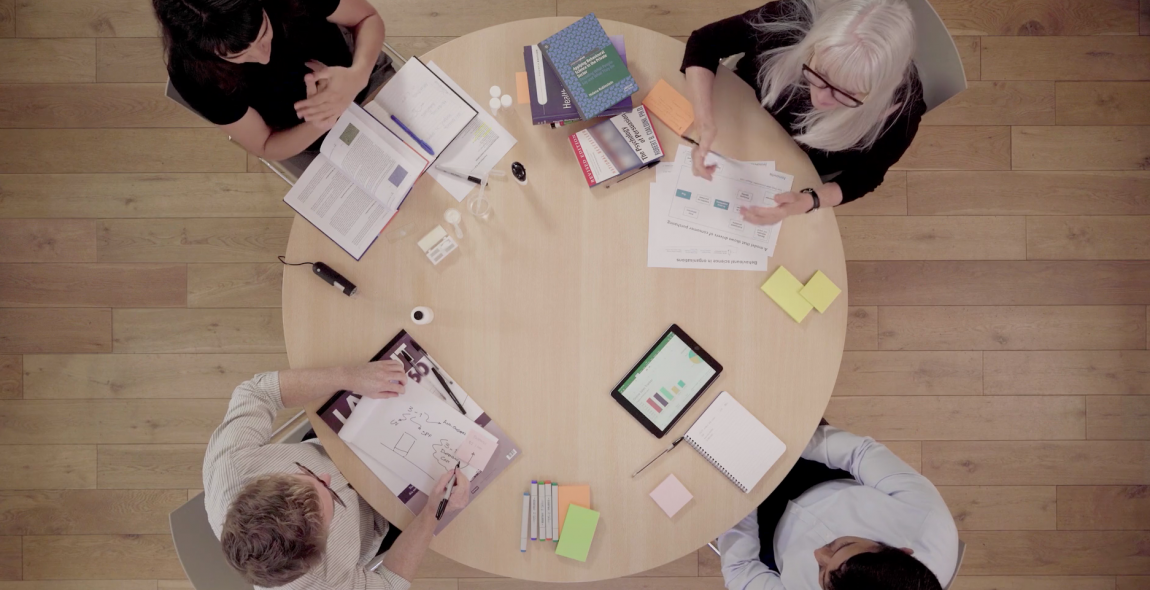Deep Read:
Behavioural science and innovation
In innovation, behavioural science helps to reduce uncertainty...... →
For general enquiries please contact us on
+44 1223 248888
enquiries2025@innoviatech.com
St Andrew's House, St Andrew's Road
Cambridge CB4 1DL United Kingdom
FIND US
How has it developed in the past 10 years? And what next?
I arrived at Innovia Technology in September 2014, fresh from working on an academic programme focused on how to get people to be vaccinated for pandemic flu (how prescient was that!). Innovia Technology was then, and still is, a company focused on front-end innovation. I had been lured from academia by the promise of working on challenging innovation projects in multi-disciplinary teams – an approach that Innovia referred to as holistic working. Many companies make this claim. To my surprise, at Innovia this turned out to be the truth. People really did work in teams comprised of people from different disciplines. In my first few months I was working with physicists, industrial designers, veterinarians, chemists and business strategists to help major corporations solve their most difficult R&D challenges.
So, what’s Behavioural Science got to do with it? How did it come to be such a fundamental part of Innovia’s approach? How has it developed in the past 10 years? And what next?

When I started at the company, there was good news and there was bad news!
1. The Good news – Innovia believed in the importance of understanding and responding to consumer needs.
2. The Bad news – its approach to gaining this knowledge was somewhat arbitrary.
Innovia seriously believed that understanding and responding to consumer needs was a fundamental part of creating breakthrough innovation. And it recognised that this understanding must come early in the process. Without it, teams go down dead ends and create great products that nobody actually wants.
But Innovia’s approach was somewhat arbitrary. It couldn’t be blamed for this, though. Many companies at that time, especially those working on new products and services, took an unsystematic approach to consumer understanding. When evidence and data was collected, it was typically data that was easiest to collect or ‘just how it is done here’. The biggest development had come from design thinking: an approach that emphasised the need for designers to empathise with users and identify their unmet needs.
I didn’t think that this was enough. History is littered with seemingly attractive breakthrough products that…never broke through. How could innovators make it more likely that new products or services will be acceptable to users? How could innovators increase the chance that a user would be willing to change deeply embedded habits to buy and use an exciting but unknown product? How could innovators de-risk new product launches by exploring if a new product or service is perceived to be useful as well as being easy to use?
I thought that better answers would come from applying Behavioural Science. Behavioural Science is a natural support for innovation because it follows the scientific method. Behavioural scientists use evidence-based behavioural models to make sense of a lot of data. They understand the decision-making process and identify which factors drive people to do what they do, not what they say they do. And they test and evaluate interventions to see whether their solutions are acceptable, feasible and effective. In this way, Behavioural Science can de-risk decisions about what to innovate on.
My scientist and technologist colleagues were quick to see the logic. They encouraged me to figure out how to make this work in a commercial context and integrate it closely with other capabilities at the company. And so Behavioural Science at Innovia was born.
In the early years, those few companies that actually thought about Behavioural Science considered only System 1 and System 2 thinking. They had come across Daniel Kahneman’s book, Thinking Fast and Slow (though I am not sure that most people had read it thoroughly!). Kahneman says that when people are faced with common but complex decisions, they tend to use an automatic, intuitive approach (System 1) which is rapid but prone to systematic errors rather than a deliberative, reasoned but slower approach (System 2).
This framework helped companies to visualise how people make decisions, but it meant they focused on specific, often unhelpful, pieces of the puzzle. First, it painted people as being essentially irrational: they are not. Second, it led to the identification of a huge number of irrational biases that supposedly guide our decision making. Systematic biases in our decision-making exist (though I am not convinced that everything that is referred to as a bias is real). However, focusing on these to the exclusion of everything else is inefficient and unproductive – they are not the only, nor are they the most important, factors in how we make decisions.
Focusing on biases in decision-making, real or imaginary, was never going to be suitable for Innovia – a place that insists on evidence and rigour! So, the approach we took at Innovia was to develop a series of steps that could make use of the best academic knowledge and translate it to the needs and rapid timescales of the private sector.
The steps are now familiar to many, but they were new and radical at the time. First, we identified the behaviour we wanted to change or influence. Then we diagnosed what was preventing the behaviour from happening. Once this was done, we could explore a wide range of possibilities to influence the behaviour before designing new products and services which could then be tested with people in concept form or as an early prototype.

We made use of a variety of validated behavioural diagnostic models. Each model helps us to see different aspects of human behaviour. The COM-B, for example, was previously only applied in public-health settings, and is a diagnostic that helps us understand what might make a person more or less likely to perform a specific behaviour. The Universal Theory of Acceptance and Use of Technology explains how people might respond to new technology. Using a variety of different behavioural models helps us to ensure that our understanding is robust and considers both general and situational factors that affect how people behave. We monitored the impact of validated behaviour change techniques to understand which solutions might have the best chance of success and we developed approaches to testing our hypotheses and new products.
These steps are now embedded and well known to Innovia and our clients. But how did it develop during the decade since its inception?

Back in 2014, the most frequent question I was asked was “what is Behavioural Science?” followed by “and why should I use it?”. We’ve explored this at a high level already, and there’s more detail in my book, ‘Applying Behavioural Science to the Private Sector: Decoding What People Say and What they Do.’
By 2016, more people had heard of Behavioural Science, and many wanted to know more. From then on, commercial use of Behavioural Science had accelerated so much that by 2018, companies were saying, “everyone does Behavioural Science. How are you better?” By 2020, many companies had Behavioural Scientists in-house and by 2022 the demand was such that organisations were struggling to recruit them. This is reflected in the sheer number of Behavioural Science teams that came into existence. In 2020, the Action Design Behavioural Teams directory listed 424 teams globally. By 2022 this had risen to 550 teams and by 2024 this had risen to 874. The UK and the USA are particularly well represented and together account for 408 teams. Competition is fierce!
1. More education opportunities: Courses on Behavioural Science sprung up at universities and commercially to train people to meet the demand. Inevitably some are more rigorous than others.
2. Company rebrands: Many companies rebranded themselves as being behaviourally based. These companies appeared knowledgeable but glossed over the limitations of ‘mind-reading’ methods (such as implicit association tests) or they focused on ‘universal’ techniques to change behaviour (such as claiming that there is only one model of behaviour). Behaviour is context dependent, and one size does not fit all.
3. Adoption by different functions at different rates: Behavioural Science was eagerly embraced in the marketing and market research community because it helped to ask better questions and to better inform communications. Financial institutions also began to use Behavioural Science in order to try to understand why people appeared to be making poor decisions about their future finances. It has been less evident in the R&D and innovation space.
4. Scandal and fear: people began to be concerned about the potential misuse of Behavioural Science. And they began to ask questions. Is it deceitful and manipulative to ‘nudge’ people without their knowledge? Is it right to exploit human biases? Is it OK to take advantage of a pattern of behaviour without a person’s consent? These concerns have been more pronounced as it became apparent that, for example, behavioural techniques were being used to make the use of social media and phones more ‘addictive.’
5. Peak hype cycle: Like many new technologies or approaches, Behavioural Science went through the hype cycle. Initially, people believed that Behavioural Science was some sort of ‘secret sauce’ that would provide them with short cuts to better solutions. Recently, people have started to challenge its impact, arguing that the evidence for its success is limited, outcomes are overclaimed, and the process is complex and expensive.
At Innovia, we have had to respond to all these developments as we’ve watched the hype cycle unfold.
To respond to the need for rigour and depth of understanding, we continued to keep abreast of the latest thinking in the field and created our own training programme to ensure that key principles are covered.
We responded to concerns about the ethical use of Behavioural Science by creating and using ethical principles for all the projects we work on: Four principles for avoiding the misuse of Behavioural Science in business.
We’ve spoken to clients who were wildly optimistic, or dispirited and cynical. But we’ve done more than watch. We’ve been testing, learning, and iterating our approach in lots of situations, with lots of different client organisations. We’ve seen how Behavioural Science can be used to create breakthroughs.
We’ve tested and observed the real-world success of interventions that we developed theoretically. One of the most demanding, yet one of the most satisfying, challenges we worked on was with Edelman on behalf of Heineken. This was a program to tackle a major problem of our time: preventing people from drinking and driving. This is an ideal problem for Behavioural Science because we could build on existing academic knowledge about factors leading to drink-driving, make an evidence-based case for the solutions to use, and design interventions that Heineken could implement and test in situ. The results were impressive: Reducing drink driving using Behavioural Science.
We’ve seen the power of Behavioural Science for supporting product development for a new and emerging user group. For example, we worked with PepsiCo to understand the cognitive drivers of sports performance and how we can improve mental performance: Understanding an emerging consumer group.
And of course, we’ve taught our clients how to use Behavioural Science themselves. So, not only have we been able to solve complex product challenges but we have also helped large corporations such as Procter & Gamble to embed Behavioural Science into their organisations: Getting closer to the truth of what matters to consumers.
However, we’ve also seen how Behavioural Science can be applied in cases it’s not suitable for. For example, one client was convinced that Behavioural Science would be a ‘magic wand’ solution to help them understand the unmet needs of the target consumers and how a product could fit into the existing marketplace. This isn’t a Behavioural Science problem. It’s much better solved using tried-and-tested marketing approaches. Behavioural Science can help to some extent, but it is not a substitute for doing the fundamental research. We helped our client see that there were more efficient, cheaper ways of reaching a good outcome.
At Innovia, we continue to see the contribution that Behavioural Science makes to breakthrough innovation. We are very aware of the importance of a rigorous and thorough approach. We consciously avoided going down the behavioural biases and ‘nudge’ route because we felt that on its own this was too narrow an approach to understanding how people make decisions. We continue to believe that for some (not all) situations, the time and effort invested in doing Behavioural Science well will ultimately provide clients with greater confidence that users will want to use and buy their innovative products and services. It has made us even more focused on hiring only the best qualified people. And it has made us even more determined to continue to develop new approaches to testing and evaluating innovative products and services.

Behavioural Science is not going away. Its use is likely to become a routine part of company activities. This may take the form of more Behavioural Scientists working in marketing and R&D departments or in the continued growth of Behavioural Science consulting.
In the light of this, here are my predictions for the future.
1. Behavioural Science will become more effective at predicting behaviour as we get access to more and better data.
Behavioural Science depends on data and evidence to understand what drives behaviour and to assess what is effective in changing it. Increasingly, companies are realising the importance of collecting and structuring their data. This enables us to make better models of behaviour and assign weights to critical factors that influence behaviour. This is particularly relevant when we’re seeking to assess how people respond to new technologies and innovative products.
2. Behavioural Science will become more effective at changing behaviour as we make use of data science tools.
Relatedly, as AI and machine learning tools become critical to analysing large behavioural databases to identify the most important drivers, we will also start to have the evidence for what works and what doesn’t. This is fundamental to being able to move forwards. The Centre for Behaviour Change is already working with others to develop tools and resources to categorise Behavioural Science approaches and to find out which interventions are effective. And why.
3. Ethics will be even more important as people will become more concerned about Behavioural Science misuse.
There have been concerns about ethics since people became aware of how Behavioural Science is being used. However, with the increased use of data as discussed above, this will become even more critical, and companies will need to have active policies in place to ensure that people are not exploited or disadvantaged. None of this is news. At Innovia, we are frequently faced with questions that have ethical importance very early on in the innovation process. We need to consider whether an innovation is not only desirable and good for business but also in the best interests of the consumer. We also need to think through whether there will be unintended consequences because of the innovations we recommend. On this basis, we always advise using ethics criteria when selecting ideas for testing.
4. Behavioural Science will become more regulated and accredited to ensure quality.
We are already starting to see this with the advent of GAABS (Global Association of Applied Behavioural Scientists) whose aim is to develop and maintain global standards.
As with any developing discipline there will be a shakedown. People will start to distinguish between which teams produce effective Behavioural Science from those that just pay it lip service. This will not happen quickly and there will be mistakes along the way leading to concerns about overclaiming and ineffectiveness.
It has been an exciting time to be involved in taking Behavioural Science ideas from academia and translating them for use in the commercial world.
We have been fascinated by watching the hype cycle play out. We’ve watched clickbaity headlines, cure-all marketing approaches, and overblown expectations come and go. We have not moved away from our deeply held belief that it is our role to understand why people do what they do, not just what they say they do.
We have resisted the siren call of only focusing on irrational biases in favour of understanding what really drives human behaviour so that we can better create breakthrough products and services. We have been privileged to work with world-leading corporations who have collaborated with us to apply Behavioural Science for good.
These are my candid reflections of what I have seen in the past decade about Behavioural Science in general and at Innovia in particular. I would really like to know what you think. Do you agree? Or not? What else do you think will happen in the next few years? Don’t hesitate to let me know at hrr-perspective@innoviatech.com

Helena joined Innovia in 2014 straight from a stint working on research to persuade people to be vaccinated for pandemic flu. She is nothing if not forward-looking! Helena was the first Behavioural Scientist at Innovia and over the subsequent decade she developed unique approaches for using Behavioural Science for innovation and built up a team of world-class Behavioural Scientists. Her experience of this can be read in her book Applying Behavioural Science to the Private Sector: Decoding What People Say and What They Do (Palgrave MacMillan)
Helena’s academic background was in social and health psychology but before coming to Innovia she ran an international brand consultancy and worked in advertising and communications. At Innovia, she continues to apply her knowledge to a wide range of sectors ranging across consumer health, fast moving consumer goods, food and luxury goods. Not only has she worked to improve and create new products, but she also acts as a trainer and mentor to clients and colleagues alike on how to use and apply behavioural science to complex challenges. In addition, Helena leads Innovia’s Strategic Advisory Group who act as advisors to the board to help steer Innovia into the future.
Outside of work, Helena is passionate about movement as in her early days she was a ballet dancer. She still does barre classes and is a trained Pilates teacher. So not only could she use her behavioural science to help you make a plan to get fit and healthy, and ensure you stick to it, but she could also teach you how to do the exercises!
Helena Rubinstein: hrr_freshperspective@innoviatech.com
Helena Rubinstein: LinkedIn